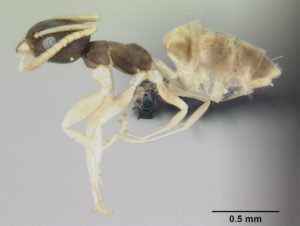Characteristics:

Photo by April Nobile URL: https://www.antweb.org/bigPicture.do?name=casent0008659&shot=p&number=1
Image Copyright © AntWeb 2002 – 2016. Licensing: Creative Commons Attribution License
- Workers are monomorphic, less than 1/16 inch in length
- Have multiple queens
- Have polydomous colonies
- Establishing colonies are most likely done by budding
- Highly mobile colonies
- Have a dark head and thorax with a pale almost translucent abdomen and legs
Ghost ants maintain colonies with multiple queens and many thousands of workers. New colonies are formed by budding. They form super colonies that readily intermingle without hostility to ants from nearby nests. Warm temperatures are necessary for ghost ant survival.
Distribution
The ghost ant, Tapinoma melanocephalum (Fabricius), is believed to have its origin in either the Orient or Afro tropical regions. This is a tramp species, introduced through human commerce into the United States and is now established in a number of locations in southern and central Florida. It has also been found indoors in more temperate climates in Texas, Iowa, Oregon, and Winnipeg, Canada. It occurs in Hawaii, the Caribbean islands and throughout tropical regions of the world. The worker caste is monomorphic and extremely small, ranging from 0.05 to 0.06 in. long. The ants are bi-colored; the head and thorax are dark brown to black and the gaster, pedicel, legs, and antennae are milky white to yellowish white. It is sometimes referred to as the black-headed ant.
Primarily an outdoor ant, like most tramp ant species, it selects highly variable sites for nesting. They can nest in warm climates in the soil in protected places, in debris, in crotches of trees, in and under logs and tree limbs, stones and other objects on the ground. Indoors they will nest in any available protected cavity. They forage on set trails.
Management
Colonies of ghost ants are highly mobile and frequently move from overpopulated nests. They are difficult to eradicate. When a colony is located, a contact insecticide may be sprayed to kill it, but a colony can be comprised of many nests and killing only the workers is a temporary solution. The best management tactic is the use of baits. These ants favor sweets. Boric acid (1-5%) in a sugar or honey water solution seems to work well. Few studies have been conducted regarding Ghost Ant control